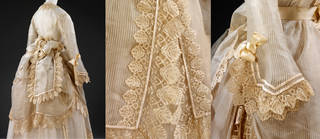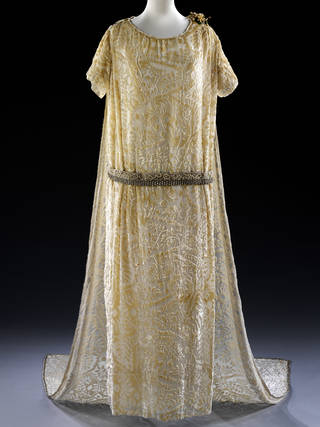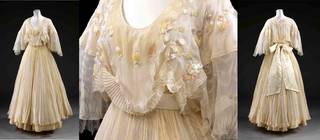In our era of accessible fashion, it's hard to imagine a time when clothes were not available 'ready to wear'. Our collection of wedding dress provides a fascinating insight into the changing approach to acquiring that most special of outfits.
One of the earliest examples in the collection is the splendid 18th century court dress. This elaborate gown would have been made by a skilled dressmaker, probably from one of the larger towns or cities, where latest fashions, technologies and craftsmanship were readily available.


In late 18th-century society, an aristocratic woman's wedding wardrobe was a mark of her status. Weddings of this era were usually more about political alliances and transfers of wealth, than romance, so the dress was an excuse to showcase the status of a bride's family. Textiles were an important means to do this, demonstrated through elaborate weaves, rich fibres and rare colours. The biggest cost of a dress would often lie in the fabric itself and not in its design or construction. Fashions changed slowly, and a wedding dress of this era would have commonly been worn again and even dyed another colour.
In the 19th century, the growth of print media meant that fashion trends could spread quickly and, as a result, were more subject to change. It also made celebrities of stylish women who were regularly reported on in the press and perhaps copied by readers. Dressmakers often held house styles and designs which a customer could commission or have altered to her personal taste. These three Victorian wedding dresses show three varying styles, all typical of their dates.



Fast-forward to the 20th century, when, with the introduction of ready-to-wear clothing, chain and department stores could easily replicate trends, creating 'off the rail' interpretations of haute couture. Latest fashions became available to those who were unable to keep up-to-date through pricey personal commissions.
The Debenham and Freebody wedding dress worn by Erica Ferguson for her wedding to Herbert Barker at St Mary's Church, Wimbledon, in 1926, is a typical example. While a comparatively affordable choice, due to its department store origins, the dress would have struck a stylish note. The colour, fabric, and semi-transparent train were bang on-trend.


Today, the majority of fashion brands – from couture lines to the high street – produce a bridal line, with the higher-end houses, like Temperley London, also accepting commissions. Modern dresses are predominantly designed to be worn for just one wedding, unlike pre-20th-century dresses which usually had an extended future in a woman's wardrobe. As in the romantic ensembles designed by John Galliano and Zandra Rhodes in the late 1970s and 1980s, wedding attire has become more fantastical and further removed from everyday fashion.





